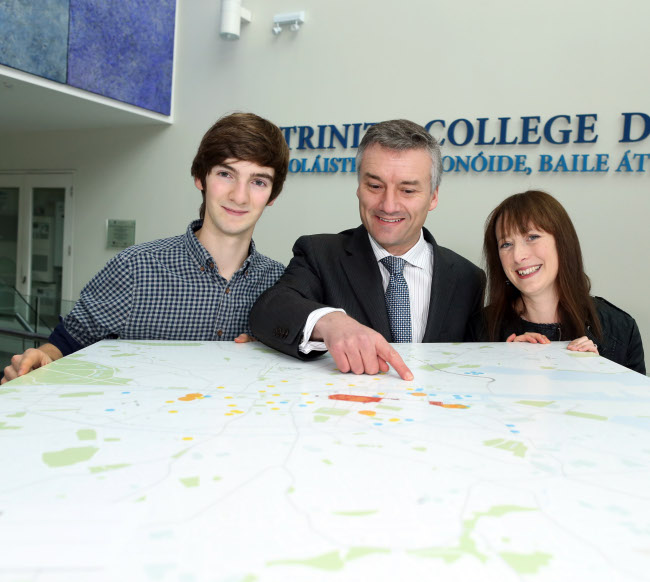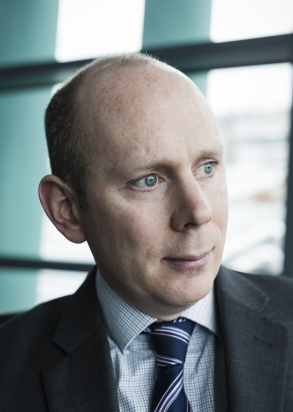There have been some 40 spin-outs from Trinity College Dublin in the last five years and start-ups emerging from the university have attracted some €60m in investment, according to the university’s director of Research and Innovation Diarmuid O’Brien.
Lots of things begin at Trinity College, that iconic 400 year-old university smack-bang in the centre of Dublin. That’s the thought that sashayed through my mind during my meeting with O’Brien.
The very office we chat in is down a flight of stairs from the room where in 1995 I met Cormac Callanan, founder of the first ISP in Ireland and where a box of wires, lights and cables signaled the dawn of the internet age in this part of the world.
Trinity College is the university from which major Irish tech success stories such as Iona, Havok and Demonware began their journey and of course the university from which the founding team behind the Dublin Web Summit emerged.
Universities all over the world are trying to emulate the innovation and entrepreneurship culture that exists in places like Stanford and Berkeley. However, in Trinity College’s case you get the sense there is a mission to be emulated rather than meekly follow the path of others.
Gateway to a Creative Quarter

Pictured: co-founders of Foodcloud Alex Sloan and Emma Mooney with Trinity Provost Dr. Patrick Prendergast in the Trinity Biomedical Sciences Institute in Dublin
In November the university unveiled its Strategy for Innovation and Entrepreneurship which targets company creation through spin-outs, spin-ins and support for student and graduate enterprises.
The new strategy for entrepreneurship that will see 161 start-ups emerge from the university in the first three years. It will also kick-start a €70m building programme that will result in a creative quarter in Dublin that will encompass Pearse Street and the Grand Canal Basin
And last month Trinity College Dublin teamed up with IBEC to provide businesses with access to university researchers. The venture will have the added purpose of exposing students to the business world and helping them to think more entrepreneurially.
“We’ve had 40 spin-outs in the last five years,” O’Brien explains. “It’s not just quality, it’s volume. These companies have attracted €60 in venture capital.”
O’Brien said that one of the key features of the university’s strategy to imbue entrepreneurship in the mind of faculty staff and students is to work with businesses up and down the country to help solve business problems by opening the firms up to research at the university.
Go your own way

O’Brien (pictured right) acknowledges that there is pressure in the international academic world to emulate the success of universities like Stanford from an entrepreneurial perspective, but he points out that every university deals with a unique set of factors in terms of geography and economy.
At the heart of the matter, he believes, is the fact Trinity is a research-driven university. “The challenge for universities is to become more Stanford-like. But not to become it in such away that it disenfranchises others who are delivering excellence in other areas within the university, be it teaching or research.
“What Trinity College wants to be defined as is primarily a research-driven university. At the heart of it from our perspective is excellence in research will enable that but also excellence in teaching.
“In terms of entrepreneurship what differentiates a high potential start-up from one that won’t succeed is the quality of the idea at the beginning. Yes there are other factors like business partners and funding, but what differentiates great companies is the quality of their idea. Typically that comes back to the quality of the research.
“If you get research excellence occurring in a university I think if you drill down you will find both excellence in teaching and entrepreneurship and that’s the critical thing for us.”
Central to the path of being a research-driven university is a teacher-researcher model for academics. “They are meant to be delivering in both of these areas and of course as that is delivered on the research side we’d hope they would start to think entrepreneurially.”
It wasn’t always this way, O’Brien admits. “Resarch wasn’t as dominant a criteria 30 years ago as it is today. Now, as we look to hire faculty the quality of the research is a hugely differentiating factor.
“Trinity is a 400 year-plus university and it is changing at the moment. You probably wo’t see that change until you look back in 20 years’ time and realise that this period of the last 10 years was transformative in terms of the focus on research, industry engagement and entreprenurship.
“As Iona’s Chris Horn would tell you that wasn’t happening 20 years ago. But Trinity College has changed, evolved and become more proactive and wants to be seen as a partner in the success of its spin-outs.
“In 20 years time you’ll ask yourself, when did all of this happen? Well I can tell you . . . it’s happening now.”
Trinity College Dublin image via Shutterstock